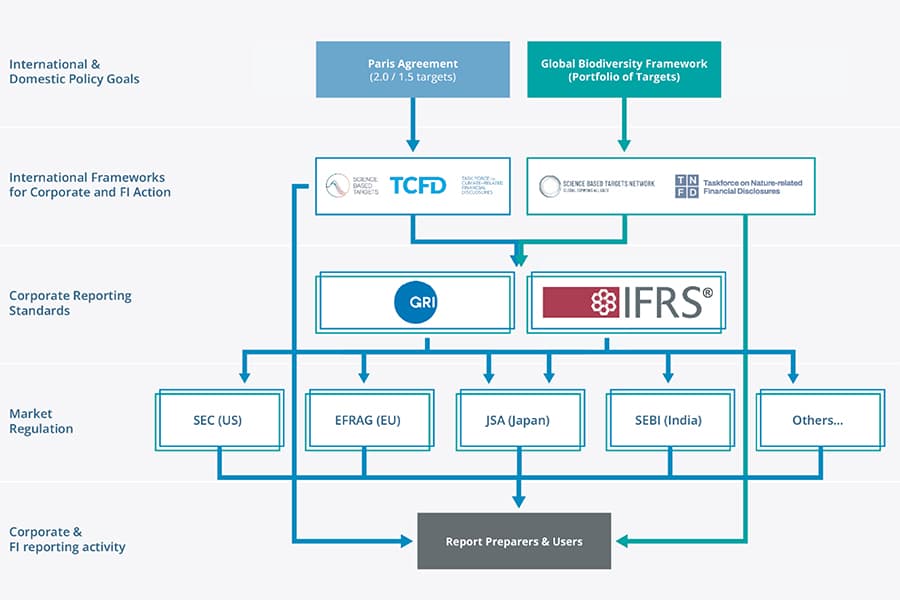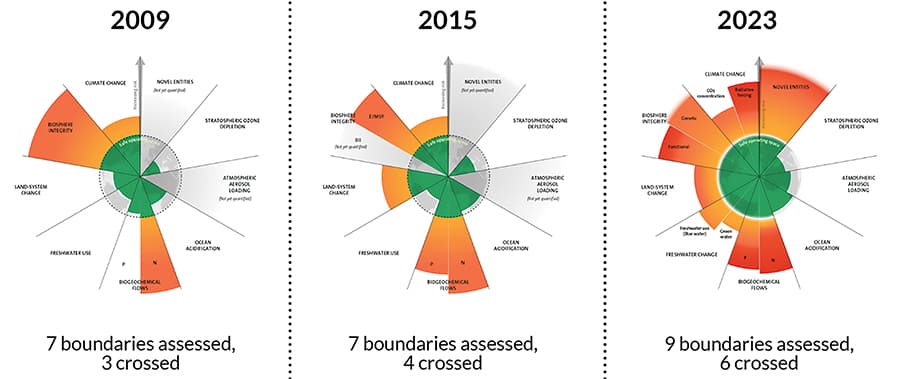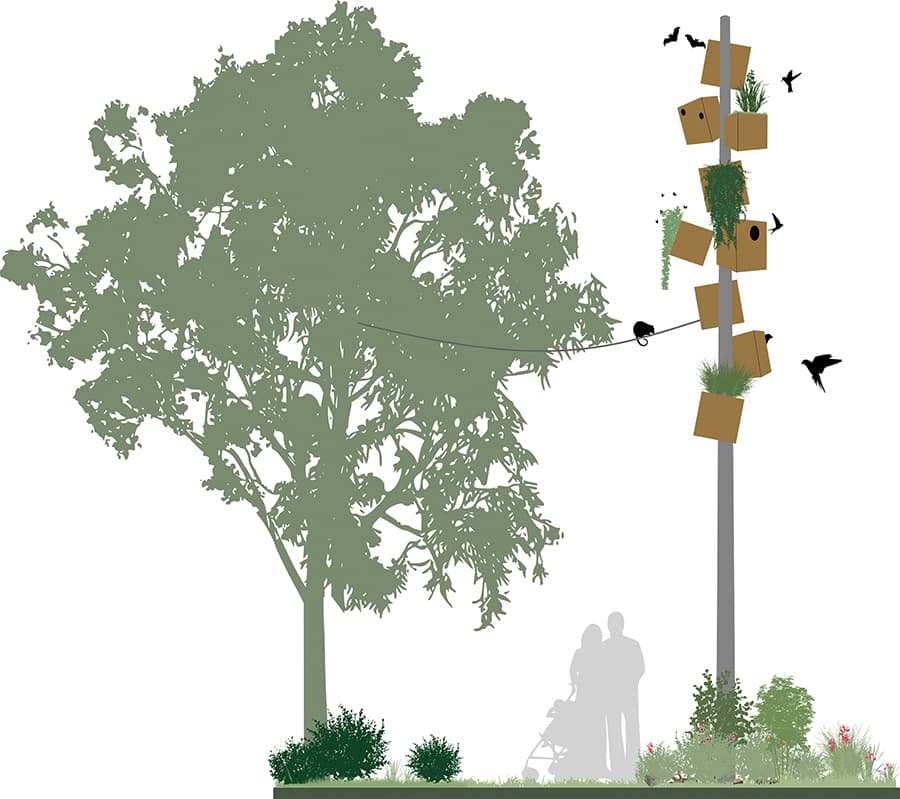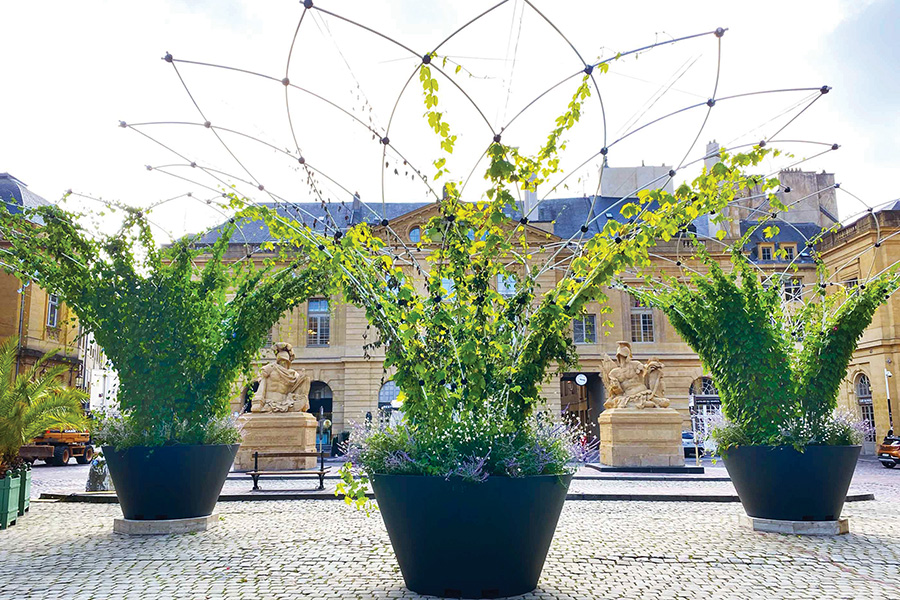With nature based reporting around the corner for many corporations, how can shopping centre developers play their part? Claire Bowles explores some innovative applications and installations that are coming to our market to solve the issue of greening our urban areas…
I recently had the pleasure of participating in a sustainable stand up comedy show and during my ten-minute set to a packed crowd at the Butterfly Club in Melbourne, I joked about our office administrator, Sally who took ‘dress down Friday’ to the next level and dressed up as a mushroom and sat in every client meeting just to get the message across that nature deserves a seat at the table. At the time, this seemed quite funny but as things are ramping up quickly in the climate disclosure and reporting space, I realise that Sally had a very good point and one we all need to pay careful attention to thanks to the International Financial Reporting Standards (IFRS) and the Taskforce on Nature-related Financial Disclosures (TFND).
At the conclusion of COP15 (the 15th Conference of the Parties) to the UN Convention on Biological Diversity in December 2022, we saw the adoption of the Kunming-Montreal Global Biodiversity Framework (GBF). The GBF aims to halt and reverse nature loss. The framework consists of global targets to be achieved by 2030 and beyond to safeguard and sustainably use biodiversity.
Australia has signed up to meaningful nature and biodiversity targets such as to protect 30% of its land and oceans by 2030.

Where TNFD fits in the Emerging Reporting Architecture
Further to this, earlier this year we saw the launch of The Taskforce on Nature-related Financial Disclosures (TNFD) – an initiative led by the private sector that aims to create a global framework to help organisations manage and disclose their nature-related risks and opportunities. The TNFD is working to shift global financial flows towards nature-positive outcomes. The TNFD framework is ready for voluntary use in the market.
Not dissimilar to the Commonwealth Climate Disclosure Policy coming out in July this year that requires all Commonwealth entities and companies to disclose climate risks and opportunities in annual reports from FY2024-25, which came out of the Taskforce for Climate related financial disclosures, we may only be a few years away from a policy that requires nature-related financial disclosures.
The Kunming-Montreal GBF and the TFND have turned nature into an issue of irreversible concern for businesses and rightly so. Not only does it state that nature needs to be protected but also that it needs to be restored and in order to do that we must be in a position to use data to measure the status of nature.
Not only are we in the midst of a biodiversity crisis but we also keep exceeding planetary boundaries in a way that is frightful. This is an existential threat to humanity and life on Earth as we know it while also threatening our economy, our livelihoods and our wellbeing. All of which depend on the health of the natural world.

Planetary boundaries over time
The 2021 State of the Environment Report presented us with an alarming story of environmental decline. Not only did it highlight that Australia’s natural environment is indeed deteriorating and it’s not resilient enough to withstand current or emerging threats but it also highlighted that native species extinction, habitat loss and cultural heritage destruction were all accelerating.
Our sector’s value chain is highly dependent on nature. The clearing of native vegetation in Australia is a major cause of habitat loss and fragmentation, as well as cultural heritage and biodiversity decline.
We are now in a position where significant drivers are in place for businesses to take nature seriously and regard it in the same light as carbon and to find ways to not only understand and report on a business’s associated biodiversity impacts but also find practical ways to bring nature into the property sector whether that be at a board level, project level or within our supply chains in order to reach the reporting requirements soon to emerge.
On projects within the built environment the old mindset of seeing greening and biodiversity as a risk, cost and pull on maintenance prevails. This will need to change to meet the requirements that are literally around the corner.
When it comes to the greening of spaces for cooling, beautification, health and wellbeing, the biodiversity gains are all well documented. The benefits speak for themselves but as we move away from greenfield development and move into inner ring densification, diversification and retrofitting, we must look for ways to integrate biodiversity in the tricky spaces between buildings that may not allow for deep root planting or traditional urban greening.
Germain Briand from Urban Canopee is driving a new kind of innovation here in Australia that he likes to call above ground landscaping that brings the benefits of trees and nature where trees cannot be planted.
“The past few decades of urbanism hyper-artificialisation have left behind large legacy parts of our cities that simply aren’t compatible with greening. The reasons are multiple: underground services, underground car parks, expensive paving… but the outcome is the same: the much-needed trees in our urban landscapes can not be planted. Countless research now clearly shows the benefits of bringing more trees into our cities (shading, cooling, wellbeing, biodiversity habitat…) We also bring a place-making twist to it making sure our solutions are good for both people, the local economy and planet,” explains Germain Briand, Urban Canopee.

Habitat pod system under development by RMIT ICON Science
Innovative applications and installations are coming to our market to solve the issue of bringing greening into urban areas that are lightweight, self contained and ideal for retail settings. These installations can green any place where trees cannot be planted. Having spoken with Germain he shared the process and described it as “quick and easy to set up with no impact on underground infrastructures and with a built in water tank… Our disruptive innovation is based on four patents and 15 years of advanced R&D on the materials and advanced calculations of lightweight structures”.
Another exciting innovation coming out of the ICON research centre at RMIT at the moment is its habitat pods.
The habitat pods, while in very early conceptual development and prototyping, seek to provide habitat, food and shelter for birds and native wildlife within cities in place of the trees and tree hollows that no longer to exist. We have heard of and are used to seeing nesting boxes but this is a new kind of urban infrastructure that will allow for customisation, species-specific habitat boxes to be installed and retrofitted on existing street poles or new poles according to site context. These habitat analogues can also be fitted with sensors and endoscopic cameras to monitor the use and occupation of the habitat boxes, driving adaptation and design refinement based on empirical observations and evidence. As we shift to reporting on nature over the coming years, we will need to look to innovative solutions particularly when we are seeking to bring life into hard to reach spaces. Cities are biodiversity hot spots and can be a large part of the solution in terms of creating habitats for species to thrive. Perhaps instead of referring to ‘nature’ as a separate thing to get attention in project meetings we should be talking about ‘life’… After all, without nature, there is no life.
This article by Claire Bowles, Regenerative Development Lead at i2C Architects is published in the latest edition of SCN magazine.





















